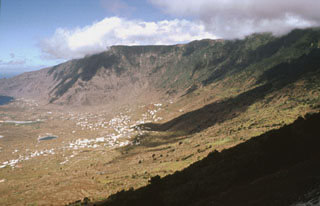Report on Hierro (Spain) — 28 September-4 October 2011
Smithsonian Institution / US Geological Survey
Weekly Volcanic Activity Report, 28 September-4 October 2011
Managing Editor: Sally Sennert.
Please cite this report as:
Global Volcanism Program, 2011. Report on Hierro (Spain) (Sennert, S, ed.). Weekly Volcanic Activity Report, 28 September-4 October 2011. Smithsonian Institution and US Geological Survey.
Hierro
Spain
27.73°N, 18.03°W; summit elev. 1500 m
All times are local (unless otherwise noted)
Instituto Geográfico Nacional (IGN) reported a drastic increase in the seismic activity at Hierro during 27 September-3 October, with more than 1,100 new seismic events detected, 83 of them felt by residents, with a maximum intensity value of IV using EMS-98 (European Macroseismic Scale). Most of the hypocenters were located offshore, SW of the island, at around 14 km depth. The maximum magnitude recorded during this week was 3.8. The total number of located events had reached more than 9,300 since the anomalous activity began on 16 July. The superficial deformation measured by the GPS network had reached 35 mm.
Geological Summary. The triangular island of Hierro is the SW-most and least studied of the Canary Islands. The massive shield volcano is truncated by a large NW-facing escarpment formed as a result of gravitational collapse of El Golfo volcano about 130,000 years ago. The steep-sided scarp towers above a low lava platform bordering 12-km-wide El Golfo Bay, and three other large submarine landslide deposits occur to the SW and SE. Three prominent rifts oriented NW, NE, and S form prominent topographic ridges. The subaerial portion of the volcano consists of flat-lying Quaternary basaltic and trachybasaltic lava flows and tuffs capped by numerous young cinder cones and lava flows. Holocene cones and flows are found both on the outer flanks and in the El Golfo depression. Hierro contains the greatest concentration of young vents in the Canary Islands. Uncertainty surrounds the report of an eruption in 1793. A submarine eruption took place about 2 km SSW off the southern point of the island during 2011-12.

